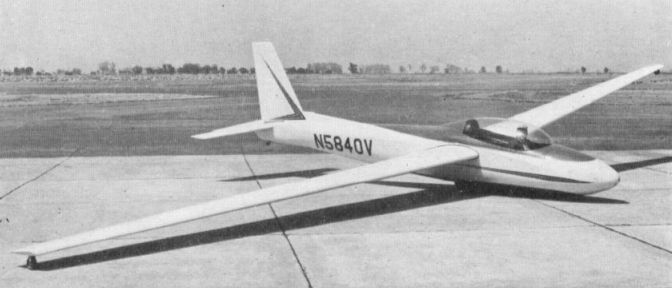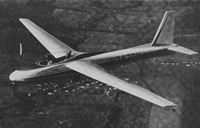Schweizer. Планеры
<...>
В 1962 году "Schweizer" разработала цельнометаллический SGS 2-32, на котором в 1960-1970 годы было установлено несколько рекордов скорости и высоты полета.
В 1968 году ВМС США закупили пять SGS 2-32 для оценки управляемости и маневренных качеств самолетов с большим удлинением крыла. Эти планеры обозначались X-26A Frigate и эксплуатировались до 1980-х годов в школе летчиков-испытателей ВМС США на авиабазе Патаксент-Ривер.
В конце 1960-х годов два SGS 2-32 ВМС США прошли модернизацию в компании "Lockheed", в ходе которой на них в рамках программы "Quiet Thruster" установили моторы Continental O-200. После испытаний во Вьетнаме QT-2PC вернули в школу летчиков-испытателей ВМС США, а обозначение изменили на X-26B.
<...>
ТАКТИКО-ТЕХНИЧЕСКИЕ ХАРАКТЕРИСТИКИ
Schweizer SGS 2-32/X-26A
Тип: двухместный планер
Силовая установка: нет
Летные характеристики: максимальная скорость в режиме буксировки 177 км/ч; максимальная скорость планирования 254 км/ч; практический потолок 5640 м; лучшее соотношение планирования на скорости 95 км/ч - 34:1; минимальная скорость снижения на скорости 80 км/ч - 0,72 м/мин
Масса: пустого 389 кг; максимальная взлетная 649 кг
Размеры: размах крыла 17,40 м; длина 8,15 м; высота 2,82 м; площадь крыла 16,70 м2
Показать полностьюShow all
M.Hardy. Gliders & Sailplanes of the world
Schweizer SGS 2-32
One of the very few sailplanes designed to carry passengers as distinct from a second pilot under training, the high performance SGS 2-32 accommodates a pilot and one very large or two average-sized passengers under a long jet fighter-type blown Perspex cockpit canopy that opens sideways; dual controls are provided, and the rear control column can be removed for the passenger's comfort. The cockpit is of a size more usually associated with powered aircraft than gliders, and among the optional 'extras' are radio, special instrumentation, electrical and oxygen systems, canopy locks, map cases, cushions and small wheels mounted at the wing tips. The prototype SGS 2-32 first flew on 3 July 1962 and FAA Type Approval was granted in June 1964, whereupon production started at once, a total of 89 having been built by January 1978. The 2-32 has set up a number of world and national records, including a new world height record for women, in Class D2, of 35,462ft set by Babs (Mary L.) Nott and Hannah F. Duncan of the United States on 5 March 1975. Of traditional Schweizer all-metal construction, the 2-32 has cantilever single-spar mid-set wings with metal covering and fabric-covered ailerons; there are air brakes in the upper and lower surfaces. The fuselage is an all-metal monocoque, and there is a non-retractable unsprung monowheel, with a hydraulic brake, and a tailskid. The cantilever tail unit has an all-moving tailplane with an adjustable trim tab in it, the fin being metal-skinned and the control surfaces fabric-covered. A special SGS 2-32 with a new wing of 67ft span with integral water ballast tanks was built in 1970 for Joe Lincoln. The SGS 2-32 was chosen by the Lockheed Missiles & Space Co as the basic airframe of their YO-3A quiet observation and reconnaissance aircraft developed for service in Vietnam through the earlier QT-2 and Q-Star, likewise based on the 2-32. The first of two QT-2s first flew in August 1967 and both were evaluated in Vietnam during the Tet offensive of 1968. The Q-Star, developed by Lockheed as a private venture, first flew in June 1968 and was powered by a 185hp dorsally-mounted Curtiss Wright RC 2-60 rotary combustion Wankel engine driving a special low speed propeller through a long prop shaft passing over the top of the cockpit. The YO-3A had a much-modified 210hp Continental 'flat six' engine in a conventional tractor installation driving a three-blade propeller. The wings were now in the low-set position, with the wheels retracting into the roots, and the pilot and observer sat under a greatly enlarged canopy, the pilot in the rear. There was a radome under the nose and fairings under the fuselage housed battlefield surveillance sensors. The SGS 2-32 also formed the basis of another quiet observation aircraft, the LTV Electrosystems L450F, which first flew in prototype form in February 1970 and was powered by a Pratt & Whitney PT6A-29 turboprop derated to 680shp.
Span: 57 ft 1 in
Length: 26 ft 9 in
Wing area: 180 sqft
Aspect ratio: 18.05
Empty weight: 850 lb
Max weight: 1,430 lb
Max speed: 140 mph (in smooth air)
Max aero-tow speed: 110 mph
Min sinking speed: 2.38 ft/sec at 50 mph
Best glide ratio: 34:1 at 59 mph
Показать полностьюShow all




